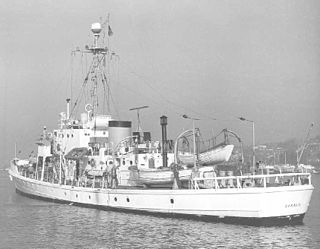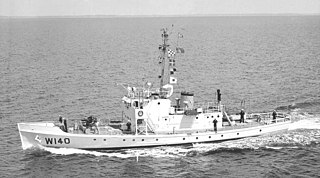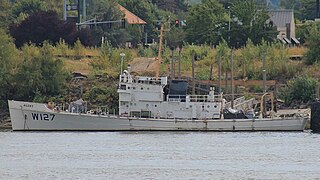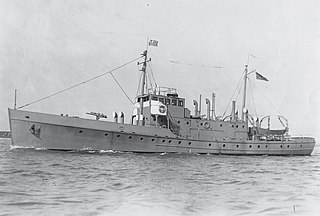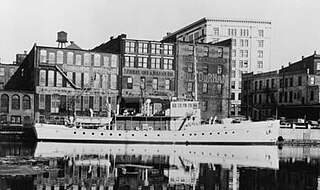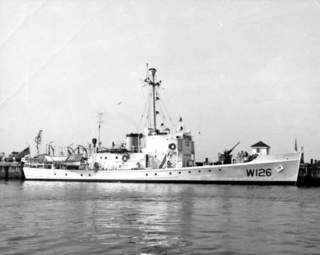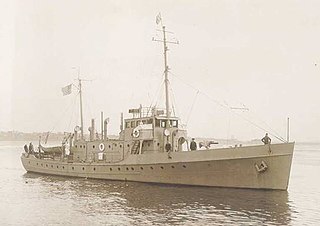| Ship name | Hull symbol | Yard number [19] | Slipway launched [19] | Laid down [19] | Launched [19] | Delivered [19] | Commissioned [20] | Decommissioned [20] | Fate [20] [19] | Notes |
|---|
| Active | WPC-125 | #320 | L | 24 July 1926 | 30 November 1926 | 12 January 1927 | 30 November 1926 | 2 April 1962 | Sold, 6 September 1963 | Used as buoy tender between 1941 and 1942. [21] |
| WSC-125 |
| Agassiz | WSC-126 | #321 | 24 July 1926 | 30 November 1926 | 19 January 1927 | 20 January 1927 | 13 October 1969 | Sold, 16 October 1969 | Damaged in collision with MV Prince George off Cape Ann, 7 July 1928. [6] |
| WMEC-126 |
| Alert | WSC-127 | #322 | 24 July 1926 | 30 November 1926 | 25 January 1927 | 27 January 1927 | 10 January 1969 | Sold, 6 October 1969 Museum ship before being abandoned and sinking on November 1, 2021, in Portland, Oregon | |
| WMEC-127 |
| Antietam Later renamed Bedloe | WPC-128 | #323 | 24 July 1926 | 30 November 1926 | 22 January 1927 | January 1927 | n/a | Foundered in storm, 14 September 1944 | |
| WSC-128 |
| Bonham | WPC-129 | #324 | 24 July 1926 | 30 November 1926 | 27 January 1927 | 29 January 1927 | 20 April 1959 | Sold, 30 December 1959 to Northland Marine Lines as Polar Star [19] Sold to Mark Benert Marine Services as Mindy B in 2005 [19] | |
| WSC-129 |
| Boutwell | WPC-130 | #325 | J | 28 August 1926 | 27 January 1927 | 8 February 1927 | 21 February 1927 | 7 May 1963 | Sold, 16 May 1964 as State Bell #296169 [22] before becoming Rebel in 1972 and Activa in 1979 [19] | |
| WSC-130 |
| Cahoone | WPC-131 | | 28 August 1926 [23] | 27 January 1927 [23] | | 21 February 1927 | 11 March 1968 | Sold, 12 December 1968 | |
| WSC-131 |
| WMEC-131 |
| Cartigan | WSC-132 | #327 | 28 August 1926 | 27 January 1927 | 2 March 1927 | 3 March 1927 | 12 October 1968 | Sold, 9 April 1969 to private owner for $26,000 [24] Lifted for scrapping in 2004. [24] | Released 300 gallons of fuel oil in 2003 while berthed at New York City [24] |
| WPC-132 |
| WMEC-132 |
| Montgomery Later renamed Colfax | WPC-133 | #340 | O | 4 December 1926 | 22 March 1927 | 4 April 1927 | 7 April 1927 | 9 November 1954 | Sold, 5 January 1956 as Colfax 271836 | Used as buoy tender between 1941 and 1942. [21] |
| WSC-133 |
| Crawford | WPC-134 | #328 | J | 28 August 1926 | 27 January 1926 | 17 February 1927 | 21 February 1927 | 15 August 1947 | Donated to Woods Hole Oceanographic Institution, 28 November 1955 Later sold to the University of Puerto Rico, 1970 Seized by USCGC Manitou (WPB-1302) for drug smuggling, 1986 Fate unknown | Used as buoy tender between 1941 and 1942. [21] |
| WSC-134 |
| Diligence | WPC-135 | #330 | 28 August 1926 | 27 January 1927 | 18 February 1927 | 22 February 1927 | 30 September 1961 | Sold, 30 January 1963 | Used as buoy tender between 1941 and 1942. [21] |
| WSC-135 |
| Dix | WPC-136 | #331 | M | 28 August 1926 | 27 January 1927 | 4 March 1927 | 5 March 1927 | 13 January 1948 | Sold, 16 June 1948 | |
| WSC-136 |
| Ewing | WPC-137 | #332 | L | 1 December 1926 | 15 March 1927 | 23 March 1927 | 26 March 1927 | 23 June 1967 | Sold, 23 January 1969 as Pacific Raider to Decorative Surfacing Centers Inc.
Extant as Pacific Hunter as of 2019; renamed 1994 [25] For sale at $124,000; moored at Ballard, California as of 2021 | Lacked the single 3 inch gun at launch [26] Used as buoy tender between 1941 and 1942. [21] |
| WSC-137 |
| WMEC-137 |
| Faunce | WPC-138 | #333 | J | 1 December 1926 | 15 March 1927 | 29 March 1927 | 1 April 1927 | 13 January 1948 | Sold, 16 June 1948 to Humble Oil Refinery as Humble AC-2 #257810, then Myra White in 1961 and Vitow II in 1964 | |
| WSC-138 |
| Frederick Lee | WPC-139 | #334 | L | 1 December 1926 | 15 March 1927 | 2 April 1927 | 4 April 1927 | 15 December 1964 | Sold, 19 May 1966 as Virgil E #505701 | |
| WSC-139 |
| WMEC-139 |
| General Greene | WPC-140 | #335 | 2 December 1926 | 14 February 1927 | 15 March 1927 | 7 April 1927 | 15 November 1968 | Sold to Guatemala, 1976 Seized by the US Coast Guard for drug smuggling, 1979 Fate unknown | |
| WSC-140 |
| WMEC-140 |
| Harriet Lane | WPC-141 | #319 | 24 July 1926 | 30 November 1926 | 31 December 1926 | 1 January 1927 | 29 April 1946 | Sold into merchant service and renamed MV Humble AC-4 #270632, 16 June 1948 to Humble Oil & Refining Fate unknown | Used as buoy tender between 1941 and 1942. [21] |
| WSC-141 |
| Jackson | WPC-142 | #336 | 2 December 1926 | 4 February 1927 | 9 March 1927 | 14 March 1927 | n/a | Foundered in storm, 14 September 1944 | |
| WSC-142 |
| Kimball | WPC-143 | #349 | 1 February 1927 | 25 April 1927 | 4 May 1927 | 7 May 1927 | 31 December 1968 | Sold, 24 February 1970 | Served as a training ship for the Merchant Marine Academy in 1939 [6] |
| WSC-143 |
| Legare | WPC-144 | #337 | 2 December 1926 | 14 February 1927 | 14 March 1927 | 17 March 1927 | 5 March 1968 | Sold, 29 November 1968 Fate unknown | Used as buoy tender between 1941 and 1942. [21] |
| WSC-144 |
| WMEC-144 |
| Marion | WPC-145 | #338 | O | 4 December 1926 | 15 March 1927 | 4 April 1927 | 6 April 1927 | 15 February 1962 | Sold into merchant service and renamed MV Top Cat, 8 March 1963 Fate unknown | |
| WSC-145 |
| McLane | WPC-146 | #339 | 4 December 1926 | 22 March 1927 | 6 April 1927 | 8 March 1927 | 31 December 1968 | Used as buoy tender between 1941 and 1942. [21] Sold, 14 November 1969 Museum ship in Muskegon, Michigan | |
| WSC-146 |
| WMEC-146 |
| Morris | WPC-147 | #341 | 4 December 1926 | 4 April 1927 | 9 April 1927 | 19 April 1927 | 7 August 1971 | Sold, August 1970 Operated by the West Sacramento Sea Scouts from 1971 [27] before being sold Museum ship in Galveston, Texas | Lacked the single 3-inch gun at construction [26] |
| WSC-147 |
| WMEC-147 |
| Nemaha | WPC-148 | #342 | 4 December 1926 | 4 April 1927 | 13 April 1927 | 19 April 1927 | 21 July 1947 | Sold, 14 June 1948 [28] | |
| WSC-148 |
| Pulaski | WPC-149 | #343 | 4 December 1926 | 4 April 1927 | 13 April 1927 | 30 April 1927 | 4 December 1946 | Sold, 14 July 1948 | |
| WSC-149 |
| Reliance | WPC-150 | #344 | J | 1 February 1927 | 18 April 1927 | 22 April 1927 | 26 April 1927 | 11 March 1968 | Sold for scrap, 16 June 1948 | |
| WSC-150 |
| Rush | WPC-151 | #345 | 1 February 1927 | 18 April 1927 | 26 April 1927 | 27 April 1927 | 21 August 1947 | Sunk in collision with M/V J. A. Moffett Jr. in Ambrose Channel, 29 December 1927, later refloated [6] Sold, 16 January 1948. Renamed Humble AC-1 with the Humble Oil & Refining Co. in 1949. Renamed Vitow I with Virgin Islands Towing Co in 1964. [29] | |
| WSC-151 |
| Tiger | WPC-152 | #346 | 1 February 1927 | 18 April 1927 | 29 April 1927 | 3 May 1927 | 12 November 1947 | Sold, 14 June 1948 as Polar Merchant #257391 Completely stripped, 2018 serving as a floating hull at Tacoma, Washington. [30] | |
| WSC-152 |
| Travis | WPC-153 | #347 | 1 February 1927 | 18 April 1927 | 26 April 1927 | 29 April 1927 | 5 June 1962 | Sold, 15 November 1962 as State Chief #294664 | Collided with M/V East Breeze off Halifax, Nova Scotia, 30 November 1944. [6] |
| WSC-153 |
| Vigilant | WPC-154 | #348 | 1 February 1927 | 25 April 1927 | 29 April 1927 | 3 May 1927 | 9 November 1954 | Sold, 3 January 1956 as Vigilant #271208 | Used as buoy tender between 1941 and 1942. [21] |
| WSC-154 |
| Woodbury | WPC-155 | #350 | L | 16 February 1927 | 2 May 1927 | 5 May 1927 | 11 May 1927 | 9 November 1954 | Sold, 3 January 1956 Renamed Humble AC-3 with Humble Oil Company as a tug. Renamed Challenge with Caribbean Towing Inc. where she serves to this day. [31] | Used as buoy tender between 1941 and 1942. [21] |
| WSC-155 |
| Yeaton | WPC-156 | #351 | 16 February 1927 | 2 May 1927 | 7 May 1927 | 10 May 1927 | 18 May 1969 | Sold, 16 July 1970 | |
| WSC-156 |
| WMEC-156 |
| Cuyahoga | WSC-157 | #329 | J | 28 August 1926 | 27 January 1926 | 17 February 1927 | 3 March 1927 | 3 November 1978 JSTOR | Sunk in collision, 20 October 1978 Refloated, 29 October 1978 Scuttled, 29 March 1979 | Transferred to United States Navy 29 May 1933, returned 17 May 1941 as AG-2. |
| AG-2 |
| WIX-157 |














